Study Guide
Field 070: Middle School Mathematics
Sample Multiple-Choice Questions
The following reference material will be available to you during the test:
Domain I—Number Sense and Computation
Objective 0001
Understand the structure and properties of number systems.
1. A number that may be written as the decimal a.b may also be written as the mixed number a a times c over d. Which of the following relationships must be true?
- d = b over c
- d = c over b
- d = 10
- d = 10times c over b
- Answer
- Correct Response: D.
The place value of b is in the tenths place and so a.b may be written as aa times b over c. The whole number a, which is common to both forms of this number, may be disregarded. The fractions b over 10 and c over d are equivalent but not necessarily identical. In general, if b over 10 = c over d then d = 1010 times c over b.
Objective 0001
Understand the structure and properties of number systems.
2. The variables a, b, c, and d represent negative integers. Which of the following statements is true?
- a over b is always positive
- c to the power of d is always positive
- a over b is always an integer
- c to the power of d is always an integer
- Answer
-
Correct Response: A.
Division of two negative numbers yields a positive quantity: negative y over negative x = open parens, negative 1, close parens times y over open parens, negative 1, close parens times x = y over x.
Objective 0002
Understand rational numbers, ratios, and proportional relationships.
3. The end-of-day price of a commodity was tracked over several months. The following ratios were obtained from that information:
- For every 2 days that the commodity did not change in price there were 3 days where it increased in price.
- For every 4 days the commodity decreased in price there were 5 days in which it did not change in price.
Which of the following ratios compares the number of days the commodity increased in price to the number of days it decreased in price?
- 3 to 4
- 5 to 9
- 12 to 10
- 15 to 8
- Answer
- Correct Response: D.
The end-of-day price comparisons of may be expressed as the unit ratio of 1.5 increases:1 unchanged. Similarly, the second comparison of may be simplified to 0.8 decreases:1 unchanged. Combine this information into a single ratio of 1.5 increases:1 unchanged:0.8 decreases. Scale this by a factor of 10 to get the result 15 increases:8 decreases.
Domain II—Algebra and Functions
Objective 0003
Understand algebraic expressions, equations, and inequalities.
4. Which of the following absolute value equations has no solutions?
- absolute value of the quantity of the fraction 3 over 2 times x minus 2 = 6
- absolute value of quantity of negative 3x + 10 + 2 = 7
- absolute value of quantity of 3x + 2 + 10 = 4
- absolute value of quantity of negative 3x minus 2 + 2 = 9
- Answer
- Correct Response: C.
The equation absolute value of quantity of 3x + 2 + 10 = 4 becomes absolute value of quantity of 3x + 2 = negative 6 by subtracting 10 from each of its sides. There are no solutions to this equation because an absolute value must always be greater than or equal to 0.
Objective 0003
Understand algebraic expressions, equations, and inequalities.
5. The work shown demonstrates how the equation 2(x + 4) = 36 minus 2(x minus 4) was created by applying algebraic properties to the solution x = 9.
| Line | equation |
|---|---|
| blank | x = 9 |
| 1 | 4x + 0 = 36 |
| 2 | 4x + 8 + (negative 8) = 36 |
| 3 | 2x + 2x + (8 minus 8) = 36 |
| 4 | 2x + 8 + 2x minus 8 = 36 |
| 5 | 2(x + 4) + 2(x minus 4) = 36 |
| 6 | 2(x + 4) = 36 minus 2(x minus 4) |
The additive inverse property was introduced in which line?
- Line 1
- Line 2
- Line 3
- Line 4
- Answer
- Correct Response: B.
The additive inverse property allows 0 to be replaced by the sum of a + (negative a). This occurs in line 2, where 8 + (negative 8) replaces 0.
Objective 0004
Understand algebraic relations and functions.
6. Use the information below to answer the question that follows.

A pattern of dots is shown progressing over four steps. A single dot appears in the first step. Two more dots are added in step two. Then three dots are added for step three and four more dots for step four, where the pattern stops.
- D sub the quantity n + 2 = D sub n + n + 2
- D sub the quantity n + 2 = D sub n + n +3
- D sub the quantity n + 2 = D sub n + 2n minus 1
- D sub the quantity n + 2 = D sub n + 2n + 3
- Answer
- Correct Response: D.
Dn, the number of dots at step n, increases by n + 1 dots to reach step n + 1. This may be expressed using the recursive equation D sub the quantity n + 1 = D sub n + open parens n + 1 close parens As the pattern continues for an additional step, the increase in the number of dots also increases by 1, D sub the quantity n + 2 = D sub n + open parens n + 1 close parens + open parens n + 2 close parens This equation simplifies to D sub the quantity n + 2 = D sub n + 2n +3
Objective 0005
Understand the collection, analysis, evaluation, and interpretation of data.
7. A car travels at a constant speed from store A to store B at 1:00 PM. Another car, departing sometime between 1:00 PM and 1:15 PM, travels from store B to store A along the same route. The car traveling to store B travels between 90–100% of the speed limit while the car traveling to store A travels at 75% of the speed limit. Which of the following graphs best describes each car's distance from store A?
-
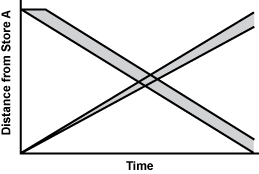
A graph is shown with labels of Time on the horizontal axis and Distance from Store A on the vertical axis. Two lines extend up and right from the origin. One of those lines rises more quickly than the other and the area between them is shaded. Another shaded region also appears on the graph. The bottom of that shaded region is a line that extends from a positive y-intercept down and right. A horizontal line segment also extends from the same intercept to the right for a short distance. It then bends down and right, extending in a direction parallel to the other line.
-
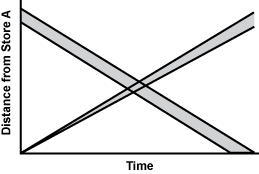
A graph is shown with labels of Time on the horizontal axis and Distance from Store A on the vertical axis. Two lines extend up and right from the origin. One of those lines rises more quickly than the other and the area between them is shaded. Another shaded region also appears on the graph. Two lines extend down and right in parallel from different y-intercepts.
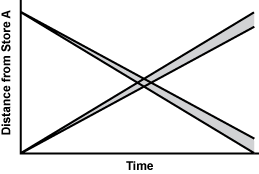
A graph is shown with labels of Time on the horizontal axis and Distance from Store A on the vertical axis. Two lines extend up and right from the origin. One of those lines rises more quickly than the other and the area between them is shaded. Two other lines, each having different slopes, share a common y-intercept and extend down and right.
-
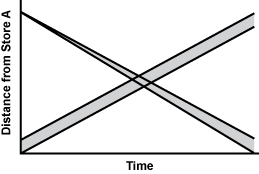
A graph is shown with labels of Time on the horizontal axis and Distance from Store A on the vertical axis. Two lines, one of which passes through the origin and another which runs in parallel above it, extends up and right. The region between those lines is shaded. Two other lines extend down and right from a common y-intercept. The region between those lines is also shaded.
- Answer
- Correct Response: A.
The line representing the car traveling to store B must begin at the origin because it is initially located at store A. The car's distance from store A then increases linearly from that point. However, the uncertainty in the car's speed, which ranges from 90 to 100% of the limit, allows for a range of possible slopes and this appears in the graph as a wedge-shaped area. The uncertainty in the location of the other car is caused by its uncertain departure time, which ranges from 1:00 PM to 1:15 PM. If the car does not move until the end of that interval, then its location on the graph will initially appear as a horizontal line. Graph A best represents this situation.
Objective 0006
Understand nonlinear relations and functions.
8. Which of the following functions has a discontinuity within the domain x is greater than or equal to 0?
- (x minus 1) (x minus 2)
- the root of the fraction of x over 6
- 2 to the power of x
- 1 over the quantity x minus 2
- Answer
- Correct Response: D.
When x = 2, the function 1 over the quantity minus 2 evaluates to the undefined quantity 1 over 0, which is a discontinuity in the domain x is greater than or equal to 0.
Domain III—Measurement and Geometry
Objective 0007
Understand units and measurement.
9. Use the diagram below to answer the question that follows.
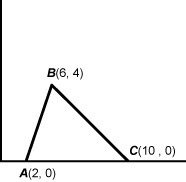
Triangle ABC is shown on a coordinate plane. Its vertices are located at (2, 0); (6, 4); and (10, 0).
The perimeter of triangle ABC is closest to which of the following values?
- 19 units
- 21 units
- 24 units
- 30 units
- Answer
- Correct Response: B.
The perimeter of the lengths is the sum of the lengths of each leg. The length AC, 8, is apparent from the coordinates of its endpoints. Apply the Pythagorean Theorem to determine the other lengths: the root of the quantity, open parens 6 minus 2 close parens squared, plus, open parens 4 minus 0 close parens squared = the root of 32 approximately equals 5.6 and the root of the quantity, open parens 10 minus 6 close parens squared, plus, open parens 6 minus 2 close parens squared = the root of 32 approximately equals 5.6. The value closest to the sum of these numbers is 21.
Objective 0008
Understand Euclidean geometry.
10. Use the information in the diagram below to answer the question that follows.
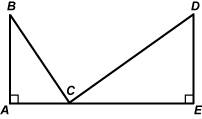
A diagram of right angle BCD, where point C is on the x-axis and points A, C, E are collinear.
Given: Angle BCD is a right angle and points A, C, E are collinear
Prove: Triangles ABC and ECD are similar
| Line | Statement | Reason |
|---|---|---|
| 1 | angle B, A, C congruent to angle C, E, D | Right angles are congruent |
| 2 | measurement of angle B, C, A + 90 + measurement of angle D, C, E = 180 | The components of the straight angle angle A, C, E add to 180 degrees |
| 3 | measurement of angle B, C, A + 90 + measurement of angle C, B, A = 180 | The interior angles of a triangle add to 180 degrees |
| 4 | measurement of angle B, C, A + 90 + measurement of angle D, C, E = measurement of angle B, C, A + 90 + measurement of angle C, B, A |
Transitive property of equality |
| 5 | measurement of angle D, C, E congruent to measurement of angle C, B, A | Algebraic cancellation |
| 6 | angle D, C, E congruent to angle C, B, A | Definition of congruence |
| 7 | Triangles ABC and ECD are similar | blank |
Which of the following reasons completes the proof?
- Angle-Angle similarity theorem
- All congruent triangles are also similar triangles
- Corresponding leg lengths are proportional
- Hypotenuses BC and CD are proportional
- Answer
- Correct Response: A.
Two triangles are similar when all three pairs of their corresponding interior angles are congruent. However, the interior angles of any triangle must always add to 180 degrees, so proving congruency between any two pairs of corresponding angles is enough to ensure congruency among all three corresponding angle pairs. In this proof, lines 1 and 6 established congruency between two pairs of corresponding angles and the angle-angle similarity theorem proves similarity between the two triangles.
Objective 0009
Understand Cartesian coordinate and transformational geometry.
11. Which of the following transformation sequences will position the image of point P at P prime?
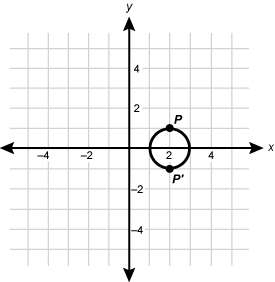
A coordinate grid is shown. A circle centered at, open parens, 2, 0, close parens, is labeled with points P, open parens, 2, 1, close parens, and P prime, open parens, 2, –1, close parens.
- a reflection over the y-axis followed by a 180 degree rotation about the origin
- a translation to the right followed by a 180 degree rotation about the center of the circle
- a translation to the left followed by a 180 degree rotation about point P
- a reflection over the x-axis followed by a 180 degree rotation about the origin
- Answer
- Correct Response: A.
The coordinates of point P change from (x, y) to (negative x, y) when it reflects over the y-axis. Rotating this point 180 degree about the origin causes each number in the coordinate pair to be replaced by its opposite value, so (negative x, y) becomes (x, negative y), and this is equivalent to a single reflection over the x-axis.
Domain IV—Probability, Statistics, and Calculus
Objective 0010
Understand probability.
12. A food retailer includes a coupon for 1 free box of cereal in 10% of the boxes it sells. What value is closest to the probability of finding exactly 1 coupon in 3 randomly selected boxes?
- 8%
- 10%
- 24%
- 30%
- Answer
- Correct Response: C.
The probability that the first opened box has a coupon and the next two do not is (0.10)(0.90) squared. However, it is also possible that the second or third box contains one coupon while the others do not, so the total probability is 3(0.10)(0.90) squared, or approximately 24%.
Objective 0011
Understand statistics.
13. Use the information in the table below to answer the question that follows.
| Mass (kg) | Temperature (degreesC) |
|---|---|
| 10 | 0 |
| 9.7 | 10 |
| 9.4 | 20 |
| 9.1 | 30 |
| 8.8 | 40 |
Data gathered in an experiment are displayed above. Which of the following values best describes the correlation coefficient?
- negative 1.0
- 0.0
- negative 0.3
- 1.0
- Answer
- Correct Response: A.
A correlation coefficient describes the extent to which one variable is linearly dependent upon another variable and may range from negative 1 to 1. For these data, the mass decreases by 0.3 kg whenever the temperature increases by 10 degreesC, which indicates a very strong negative linear relationship between these variables. The best correlation coefficient to describe this relationship is A.
Objective 0012
Understand calculus.
14. Use the information in the graph below to answer the question that follows.
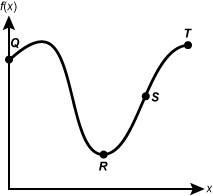
A graph with a horizontal axis labeled x and a vertical axis labeled f of x is shown. The curve begins at the second highest of the labeled points, Q, which is positioned on the positive y-axis. The curve gradually rises and then sharply falls to its lowest point, R, which rests at the bottom of a bowl shape in the curve. The curve then rises steeply in an upward-J shape to reach point S. From there, the curve extends upward, although more gradually, through point T. Point T is the right-most labeled point and is positioned just above point Q.
The value of the derivative is greatest for which of the points labeled in the graph above?- Point Q
- Point R
- Point S
- Point T
- Answer
- Correct Response: C.
The derivative of f of x is the instantaneous rate of change of the function at point x. It is also the slope of the line tangent to the function at that point. Of the points shown, the value of the derivative is greatest at S.
Domain V—Instruction and Assessment
Objective 0013
Understand content and process standards and instructional strategies.
15. Students in an eighth-grade math class studied how to solve equations of the form ax + b = c in an earlier unit. Data from that unit’s summative assessment indicate that some students have difficulty understanding how to interpret an equation’s variables and operations, whereas other students can use equations to model situations independently.
As part of a lesson to introduce students to properties of linear relationships, the teacher will use the following equations as part of a learning activity.
| y = negative 6x + 12 | y = 5 over 3x minus 5 |
| y = negative 5 over 6x + 10 | y = 4x minus 8 |
Considering the variability in students’ mathematical backgrounds, which of the following questions will best supports every student's ability to strengthen their knowledge of linear equations?
- How could these equations be separated into groups?
- How could these equations be made into word problems?
- How could these equations be solved for the variable x?
- How could these equations be entered as spreadsheet formulas?
- Answer
- Correct Response: A.
Students who have not yet mastered prior equation concepts need tasks that develop, but do not require, this knowledge. Students with a more advanced understanding of equations need tasks where they apply this knowledge in new ways. The grouping task promotes understanding and engagement by fulfilling both needs. Some students may focus on straightforward observations, such as grouping equations by the signs of the variable coefficients, whereas other students may pick up on deeper connections, such as how negative 6x + 12 and 4x minus 8 both evaluate to 0 when x = 2.

